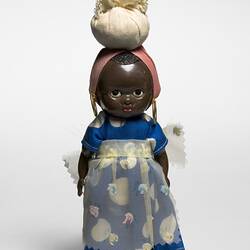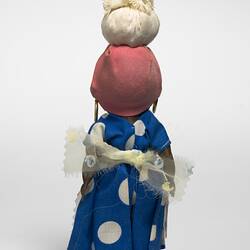Summary
National doll produced to represent a Cuban woman, it was sent to Monica Gates in 1959 by friends or family who had visited South America. Colonised by the Spanish in the 16th Century, agricultural products such as sugar, coffee and tobacco were and remain an important part of Cuba's economy, to develop the agricultural industry the Spanish brought Africans to Cuba to work on the plantations. Following the abolition of slavery and independence from Spain in the early 20th Century this group largely remained constrained by racial prejudice and poverty, with women often working as seamstresses, domestic workers or laundry workers. This doll with its ankle-length dress, apron, headscarf and parcel on her head is a typical representation of an Afro-Cuban woman's dress and work until the mid 20th Century. It was only with the socialist revolution of 1959 that these women found greater opportunities to break away from these types of roles, although they are still often constrained by socio-economic circumstances.
The Gates collection contains 170 national dolls from 74 different countries and some correspondence relating to the acquisition of several of the dolls. The costumes of the dolls represent national costumes from the 19th Century to the 1990s. Monica Gates collected or was given these dolls between 1957 and 1990.
These dolls were purchased as souvenirs of particular countries and like many mass produced souvenirs they are often not accurate representations of a particular country or region, and may actually better reflect neighbouring counties or regions. This occurs because costumes are often stylised and simplified resulting dolls wearing generic costume elements which are common to many countries/regions. Often the fabrics and decorations used are selected to make the dolls cheap and easy to manufacture and aesthetically pleasing. This can result in the fabrics, colours and decorations of the doll's clothing having little or no reflection of the costume associated with a particular country or region they are meant to be representative of.
Physical Description
Female doll wearing a blue dress with a pattern of large, white dots. Around the waist is tied an apron of thin material with small flowers on it. She has black shoes painted onto her feet. Her hair and mouth are also painted on, but her eyes are inlaid perhaps with plastic. She has a pink scarf tied around her head on top of which is a parcel wrapped in cream material She also wears gold loop ear-rings.
More Information
-
Collecting Areas
-
Acquisition Information
Purchase
-
Place Made
-
User
-
Other Association (See Comments)
Cuba
Doll is a typical representation of Afro-Cuban women in the 19th and early 20th centuries -
Classification
-
Category
-
Discipline
-
Type of item
-
overall dimensions
6 cm (Length), 4 cm (Width), 20 cm (Height)
-
Keywords
Children's Play, Clothing, Cultural Awareness, Cultural Beliefs, Dolls, National Costumes, National Identity, Souvenirs




